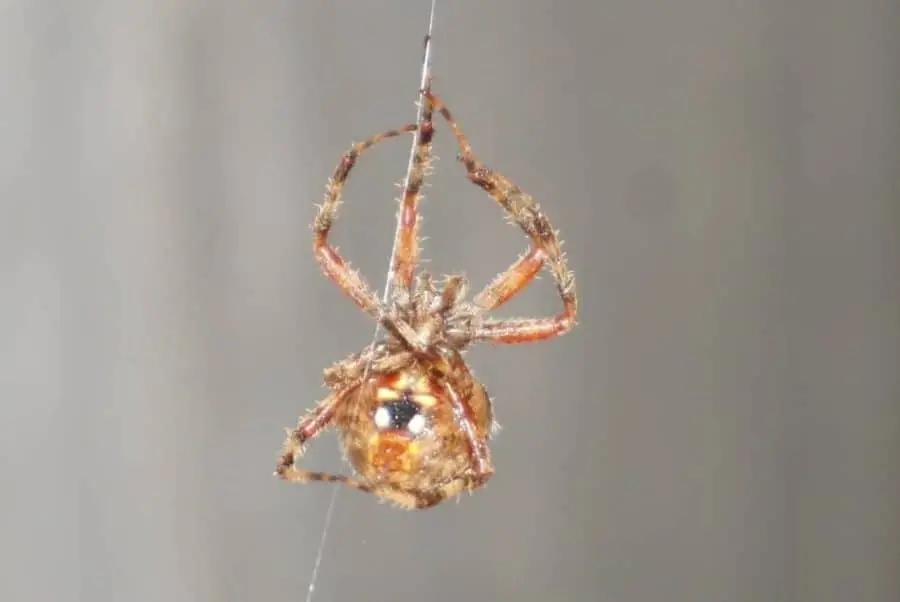I have always wondered about this even before I became a pest exterminator.
What time of year do spiders lay their eggs? The brief answer is that spiders multiply all year. Even though they will appear less active in the winter and fall they will still mate, lay eggs, and feed.
Where Do Spiders Lay Eggs?
Spiders won’t usually lay their egg sac in a easy to reach place. They normally find a place that is protected from the elements and predators.
Many species of spider will protect the sac with many layers of silk, followed by a web. Spiders will also stay around and guard the egg sac as to protect their little spiderlings from harm.
Some spiders carry their spiderlings on their back until they are big enough to go out on their own.
How Many Eggs Do Spiders Lay?
The female spider will typically lay between 15-20 egg sacs during their lifetime. There is usually about 150-200 eggs in each egg sac. This is a general answer for most species of spider. as some spiders don’t use an egg sac.
Where Do Spiders Go When They Hatch?
The young nymph spiders will when they are ready leave the egg sack and venture out into the great unknown.The exception to this is in the colder months the immature spiders will stay in the sac and wait it out until spring. Spiderlings will cast their parachute silk string and drift away they don’t travel very far from there point of origin. They will the immature spiders will stay in the sac longer during the colder months.The young spiderlings will be seeking out the light, but when they get older they will prefer the darkness.
Lots of the spiderlings will be devoured by predators, such as the praying mantis, and blue lizards etc. Although only a small percentage of them will survive to adulthood, the population will increase if left unchecked.
Where Do I Find Spiders In And Around My Home?
While very hardy and versatile creatures, spiders do have certain places that they like to seek out in order to lay their egg sacs. They like to find somewhere without too much moisture, noise or light. Wood piles, under rocks, and compost provide a perfect location for them to lay their eggs.
If you ever look at your bushes and trees just outside your home, it is easy to find spiders webbing all throughout those areas. Alway make sure to cut back foliage and vegetation from directly touching your home as to avoid unwanted infestations.
Other places that spiders prefer are:
- Crawl spaces/Basements
- Window fixtures
- Sheds, and other dry outdoor places
- Attics
- Inside cracks in the walls
- Under your Furniture
There are ways to deter spiders from laying eggs on your property. You can use a cobweb duster to brush the inside and outside of your home, or any other affected areas. Downspouts, window sills, eaves and soffits, doorways, as well as some of the other places previously mentioned, are the areas you want to target.
You will generally find spiders where they can have a good meal too, this means if you keep other pests away you can keep the spiders away too.
What are Some Tips For Dealing with Spiders?
If you decide to work out in the garden make sure to wear gloves as to avoid an unwanted bite. Even though not all spiders are poisonous you will still feel discomfort or itchiness from a spider bite.
Fall is the prime time for pest infestations. As food supplies diminish due to cooler weather, and many of the bugs set about their searches for safe places to wait out the winter. Arachnids (spiders) during this time of year begin to make more public appearances. Even though arthropods (spiders) are more shy by nature, and have a tendency to stay out of sight, they will work their way inside. Many of the nation’s arachnid species are harmless, although certain exceptions could be moving into your home as we speak.
What Spiders Are Dangerous In North America?
There are 2 spiders indigenous to North America That are considered most dangerous to humans:
Brown Recluse – This spider will usually bite unintentionally, It will usually happen when a hand or foot goes across a place that the spider is hiding and as a knee-jerk reaction it bites. When they bite there is normally no pain at first but as the venom makes it’s way into your bloodstream pain and skin deforming will start to happen. So it takes just hours to recognize that it happened, and weeks for it to fully heal if medical attention is sought out.
Black Widow – Even though death is rare when dealing with the Black Widow, and with none reported in more than 10 years , these statistics offer no comfort when thinking of the potential danger.
If you are ever bitten by a black widow please seek medical attention immediately.
Symptoms Can Be:
- Redness, pain and swelling at the place of injection
- Headache
- Sweating
- Dizziness
- Nausea
- Chest and/or abdominal pain
- Difficulty breathing
- Trembling
- Limb paralysis
Fun Fact – Some black widow spiders have a red hourglass, some have two red or orange spots on their abdomen and some have no marks at all but their body shape is still the same!
Important –
If you find yourself or a loved one was bit by one of these spiders it is important to keep an eye out especially as a child or elderly person can be more susceptible to worse reactions or death.
Pest Insider Secret: You can use commercial chemical like the pros to treat your own home.
What Treatment Options Work Best For Spiders?
As much as spiders can be a good thing to have around too much of a good thing can not be good at all, that being said;
Here Are Some Treatment Options:
Non-Chemical – Keep cobwebs down in and outside your home. The tool you will want to use for this is a web buster. i.e. cobweb duster. Keep in mind if there is nothing in or around your home for spiders to eat they will move on. Always make sure to keep your home clean as to not invite other bugs in your home, it will help keep the spider population down.
Chemical Treatment – Talstar P is a wonderful chemical to use outside your home that is easy on the wallet. With the active ingredient bifenthrin it packs a punch but is safe enough to use for folks with children or pets. Once this chemical drys it lasts about a month.
On the inside of your home there is a great chemical that micro-encapsulates (is the process in which the chemical after it dries gains a long lasting protective coating). The chemical is called Demand CS. Demand CS has an active ingredient called lambda cyhalothrin it lasts up to 60 days inside your home if it is not broken down by mopping or carpet cleaning.
Summary:
Spiders do lay their eggs all year and you can expect that if they make their way into your home in the fall that there will be hundreds trying to make there way around in the spring. This is manageable with proper treatment and cleanliness you can rest easy without worry if you are proactive about it.
Related Topics:
How Much Can I Save Doing Pest Control Myself?
The average annual pest service can cost between $300-$700 dollars. The cost of having a Pest Control Company service your property will range from $75.00 – $150.00 dollars per visit, or more if there are large complications. The initial cost you will spend is between $65.00- $100.00 if you decide to treat yourself!
Remember when I said the chemical goes a long way? To treat your home you will use anywhere from 1/2 an ounce to 1 ounce of chemical per gallon of water. The average cost per treatment when you do it yourself is between $5-$15 per application. So the money spent for chemical will last a long time.
How Long Does Pest Control Last?
This will vary. When you apply a pesticide outside the elements can break the chemical down faster than it’s intended use. Chemicals can break down sooner if you have extended rainfall, flood, or snow. The sun also plays a factor in this equation. Most chemicals break down in 4-6 weeks. This is if you have normal conditions some rainfall is okay, but if it rains for a week straight you can expect that what you put down is likely not there anymore.
When you apply pesticide indoors the residual is longer because it is protected. Inside your home the chemical will usually last the full 4-6 weeks. Chemical can break down when mopping your floors or using other cleaners in the treated areas, but that would take many cleaning applications.
KEEP IN MIND… You should never apply a pesticide outside while it is raining! This could run off to waterways and contaminate natural habitats, creeks, ponds and drinking water

